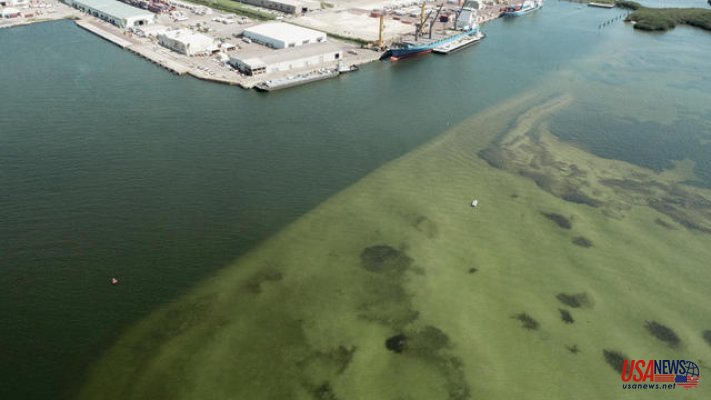The incident started last year, when the company responsible for Piney Point, HRK Holdings found a tear within the liner of the gypsum pile. This liner prevents millions of gallons worth of mining wastewater and dredged material from seeping through a large phosphogypsum stack, which is a huge mound of phosphorus mining byproduct. The structural integrity the entire stack was affected by the leak, leading officials to evacuate residents concerned about the possibility of the stack collapsing and unleashing a huge flood of water.
Officials had to pump the wastewater into local waterways in order to stop this from happening. In just 10 days, 215 million gallons worth of wastewater containing toxic levels and other nutrients were released into Tampa Bay.
Marcus Beck, the lead author of this new environmental impact study, said that it was the "largest release [the facility] has ever had to date." High levels of phosphorus, nitrogen and other nutrients were found in the water. This can cause a "cascading environmental response" that could be detrimental to other bay resources.
Beck stated that "it's something the ecology, and the system can't handle." "...Tampa Bay has an estuary that's nitrogen-limited. This means that nitrogen will fuel algae blooms if it's added to the system. There are many cascading effects that could result from this.
From March 30 through April 9, 180 metric tons of nitrogen, a year's worth, was released into the bay. Beck and his team began to notice a "run-of-the-mill, nonharmful species of algae" that had grown around the Piney Point discharge point. Beck stated that abnormally large floating mats of filamentous Cyanobacteria appeared south of Tampa Bay in May and June. These can be dangerous at large quantities.
These mats vanished quickly, but red tide began to peak, an enormous algae bloom that is dangerous to marine life and humans. When conditions are favorable for red tide growth, it originates in the Gulf of Mexico. It then appears in Tampa Bay. It was common in the past when there was little rain and high ocean salinity.
According to Beck, 2021 was the year with the greatest concentration of red tide since 1971. This caused heavy fish kills, and forced people to leave the beach. The neurotoxins in the algae caused eye and nose burns.
Beck stated, "Red tides are toxic."
Beck stated that the bloom at the discharge location, the massive cyanobacteria mat, and the red tide aggressive bout were all signs that this was not a typical year for the bay. The researchers stated that although the red tide was not caused by Piney Point's wastewater discharge, there is "multiple evidence" for an adverse environmental reaction.
Beck stated that "what we believe happened was that the red tide moved into the bay from Gulf and there was essentially plenty of food for it -- nutrients either from the original discharge, or released after decomposition the initial phytoplankton flower or the cyanobacteria."
Even though it has been a year since the last time, there is still the possibility of it happening again. On April 15, approximately 258,000,000 gallons of water were still in the gypsum pile.
A plan was approved by the state to close the stacks. However, it may take another year to fill the well with water. The state approved a a href="https://content.govdelivery.com/attachments/FLDEP/2022/03/02/file_attachments/2092442/Conceptual%20Closure%20Plan_Reduced.pdf">plan to close the stacks, a a data-invalid-url-rewritten://http="https://www.cbsnews.com/news/piney_point–wastewater–deep–well-environmentalists-controversy/>well, but it could take another year before it's.
"A frightening thought"
Scott Hopes, Manatee County Commissioner, stated to CBS News that the gypstacks can hold approximately 25 inches of rain.
Hopes stated, "That's scary because it only takes an above-normal storm during our hurricane season for more water to drop than the stacks are capable of holding." "Fortunately, there is another backup retention pond."
The water is still being treated. Beck stated that the nitrogen load from the plant has decreased to between three and four milligrams per Liter, as compared to 200 milligrams per Litre. Hopes claimed that the water is still being stored at around 100 to 150,000 gallons per day. These levels are still higher than the Tampa Bay baseline nutrient concentrations so there would be an "important load influx" if another spillage occurs.
Beck stated that while it would still be a concern, it is not as serious as last year's initial release. "Stormwater management will always be a concern at this place until the water has been completely removed."
Even after the closure of Piney Point 's phosphate mines, more than two dozen other facilities are still operating in Florida, nine of them active, according the Florida Department of Environmental Protection.
Hopes stated that Piney Point's problems should have been addressed years ago.
He said that there was an opportunity to finish the last chapter before HRK took over this site. That's what should have happened. "... Only companies with experience in managing this kind of industrial site should be allowed to participate in this type.
Hopes stated that he believes "many people" have learned a lesson and that he would not expect what happened at Piney Point to ever happen again in Florida.
However, there have been other hazardous issues at several other locations. According to The Tampa Bay Times, a 45-foot wide sinkhole formed beneath a gypstack at Mulberry's phosphate fertilizer plant. It released at least 215,000,000 gallons wastewater into the Floridan Aquifer. According to WUSF Public Media, the state has been examining a potential tear in the lining at a Polk County gypstack. Mosaic, which owns those two sites, is applying for a permit from Florida's Department of Environmental Protection in order to expand a Gypstack at the facility believed to have a tear.
Beck stated that fertilizer is an important part of modern society. However, Beck suggested that there needs to be greater oversight and regulatory oversight regarding the long-term implications of the management of these sites. "... If there is a new site, making sure there is a plan to ensure that the wastewater and any other environmental effects from that site are managed in a way that is not harmful to the community.
Beck and his team are currently studying the long-term effects of last year’s discharge. They are particularly interested in the effect it might have on seagrasses. Seagrasses can take longer to adapt to environmental changes. The bay ecosystem is dependent on seagrass, and manatees depend on it for their food. Last year's record-breaking numbers of dead from starvation caused by the discharge were shocking.
"We can only hope for the best. Having these types of discussions and making people aware that there are concerns" Beck stated, and making sure that those responsible for managing these sites in a responsible way are held accountable.












